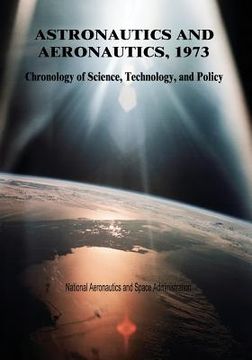Compartir
Astronautics and Aeronautics, 1973: Chronology of Science, Technology, and Policy (en Inglés)
National Aeronautics and Administration
(Autor)
·
Createspace Independent Publishing Platform
· Tapa Blanda
Astronautics and Aeronautics, 1973: Chronology of Science, Technology, and Policy (en Inglés) - Administration, National Aeronautics and
35,60 €
37,47 €
Ahorras: 1,87 €
Elige la lista en la que quieres agregar tu producto o crea una nueva lista
✓ Producto agregado correctamente a la lista de deseos.
Ir a Mis Listas
Origen: Estados Unidos
(Costos de importación incluídos en el precio)
Se enviará desde nuestra bodega entre el
Miércoles 17 de Julio y el
Miércoles 31 de Julio.
Lo recibirás en cualquier lugar de España entre 1 y 5 días hábiles luego del envío.
Reseña del libro "Astronautics and Aeronautics, 1973: Chronology of Science, Technology, and Policy (en Inglés)"
This volume in NASA's continuing series of annual chronologies records the events of 1973. The 15th year of the space agency's existence is memorable to the public as the Year of Skylab and the Year of Jupiter. The nation's first earth-orbital laboratory was launched. Beginning with a dramatic 10-day fix-it effort that restored Skylab's capability to generate electrical power, three three-man crews rendezvoused and docked with the space laboratory. Their total of 12 351 man-hours in space supported the feasibility of prolonged manned space flight. Even more impressive were the volume and quality of experiment results. The sophisticated battery of telescopes in the Apollo Telescope Mount produced 182 842 frames of film and 941 hours of manned viewing of the sun. The earth was not neglected either. Orienting the laboratory toward the earth, astronauts took a total of 40 286 frames of earth-resources photographs. Electric furnace experiments with zero-gravity manufacturing offered interesting possibilities of new industrial processes that cannot be achieved in earth gravity. Assimilation of the knowledge contained in the mass of data is still continuing. As the year closed, Pioneer 10 swept by the planet Jupiter after a 21-month flight that traversed a billion kilometers. Passing through the intense radiation surrounding the largest planet in our solar system, Pioneer 10 sent back 300 close-up photographs of the planet and its inner moons, along with other measurements of the swirling atmosphere and its massive Red Spot and of the magnetic, radiation, and electrical environments. Even as it returned the data-much of which contradicted previous theories-Pioneer 10 was heading outward toward the orbits of Saturn and Pluto. In the late 1980s it will become the first man-made object to leave the solar system and voyage into interstellar space. The events of Skylab and Pioneer were only the most visible successes of 1973, however; many other important events accomplished their objectives with less notice. On a smaller scale, but particularly important to a few, was the announcement of a new heart pacemaker developed from electronic components and batteries originally designed for use in space. The new model was rechargeable, thus eliminating the need for periodic surgery to replace the earlier instrument. Uses for the vast amount of data from the Earth Resources Technology Satellite Erts 1 multiplied as it completed its first year in space in July 1973: planning land use, managing water resources, estimating crop yields, inventorying timber, exploring for minerals and petroleum. The practical benefits from this and similar programs seem at this writing almost limitless. Indeed, the principal problems are no longer the acquisition of such data, but rather its rapid and economical reduction int9 usable forms. In aeronautics, work went forward on a number of programs: digital flyby-wire, which will significantly improve aircraft control; the supercritical wing, which provides significant fuel savings; reduction of noise and pollution; and hydrogen injection to increase efficiency and reduce pollution from gasoline engines. Collectively these efforts promise safer flight, fuel economies, and less damage to our environment. Thus on most counts NASA activities seemed to bear out the Administrator's statement in late 1973 that NASA was providing more emphasis on becoming "more like one of the service agencies of the government."

